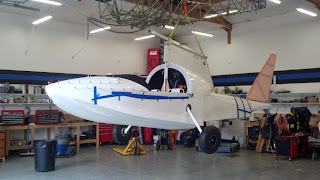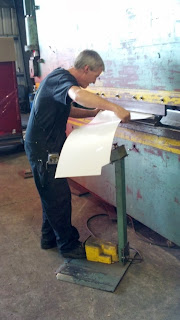I ran out of landing currency at work and the sims are all booked up, so I've got some time off this week. I've been pushing hard the last several months and my body has held up really well, but once I told my body it could relax it immediately went "Whew, ok thanks!" and got sick. Nothing serious, just a mild cold that has left me fuzzy headed and not really up for critical work.
Einar's shop faces south, so if you're going to be sick you might as well go sit in the sunshine and look/work on airplanes.
When I installed the GTR200, I only had time to hook up the cables to see if everything worked ok, but I didn't have time to lace up and properly wire them in. Simple, repetitive work to knock out when sick, but when done gives a feeling like you've done something.
Slowly, gradually the wires were tamed and laced into place. Still got some work to do, but after a while I needed to take a break and play with my new toy.
Guess I'm sicker than I'll admit, I didn't feel comfortable climbing into the cockpit but instead just pulled up a chair and leaned over the sidewall to look in, and baked in the sun.
If you've never heard the term RTFM, it translates to "Read The F(unny) Manual". Hooking up the wiring is simple, but integrating the Dynon and the Garmin took some headscratching, reading, and patient tech support from Tim at Approach Fast Stack Avionics. Can't say enough about their product, and their service.
"Back in my day, we had paper manuals, and we had to look things up by hand, none of this CTL-F fast lookup stuff in Adode format. And we had to tune our own radios by hand, dang nab it!!!" (I do miss paper manuals you could highlight with a yellow marker, underline and scribble notes in the margin and turn pages down to mark important stuff. Also, it's kind of fun to go back years later and reread them, think "Man, I remember when that was HARD!")
But seriously, a long time ago I used to be a Line Check Airman at Continental Express on the EMB-135/145, the best job I've ever had in aviation since it combined teaching and flying. I'd tell the new guys coming on board that it would take them about 300 hours to get comfortable with the glass cockpit, about 600 hours to really understand it, and at about 1,000 hours they'd get complacent and the avionics/airplane would bite them, hard. Some of these kids were coming on board with 500 hours total time, and were trying to learn an advanced glass cockpit airliner AND fly out of Newark/NY TRACON. The learning curve for them was steep, and as an IP some days were "sporty". We all survived, somehow, and one of the best feelings in the world is when I run into old friends who are no longer the FNGs but are now seasoned, accomplished aviators with their own experiences I can learn from.
I'm not going to be paid to fly Osp 4-6 legs 16 hours/day for months at a time to learn her systems, so instead I'll be spending a lot of soft time this winter sitting in her, playing with buttons and going "What does THIS do?" until it's second nature.
Einar's shop faces south, so if you're going to be sick you might as well go sit in the sunshine and look/work on airplanes.
When I installed the GTR200, I only had time to hook up the cables to see if everything worked ok, but I didn't have time to lace up and properly wire them in. Simple, repetitive work to knock out when sick, but when done gives a feeling like you've done something.
Slowly, gradually the wires were tamed and laced into place. Still got some work to do, but after a while I needed to take a break and play with my new toy.
Guess I'm sicker than I'll admit, I didn't feel comfortable climbing into the cockpit but instead just pulled up a chair and leaned over the sidewall to look in, and baked in the sun.
If you've never heard the term RTFM, it translates to "Read The F(unny) Manual". Hooking up the wiring is simple, but integrating the Dynon and the Garmin took some headscratching, reading, and patient tech support from Tim at Approach Fast Stack Avionics. Can't say enough about their product, and their service.
"Back in my day, we had paper manuals, and we had to look things up by hand, none of this CTL-F fast lookup stuff in Adode format. And we had to tune our own radios by hand, dang nab it!!!" (I do miss paper manuals you could highlight with a yellow marker, underline and scribble notes in the margin and turn pages down to mark important stuff. Also, it's kind of fun to go back years later and reread them, think "Man, I remember when that was HARD!")
But seriously, a long time ago I used to be a Line Check Airman at Continental Express on the EMB-135/145, the best job I've ever had in aviation since it combined teaching and flying. I'd tell the new guys coming on board that it would take them about 300 hours to get comfortable with the glass cockpit, about 600 hours to really understand it, and at about 1,000 hours they'd get complacent and the avionics/airplane would bite them, hard. Some of these kids were coming on board with 500 hours total time, and were trying to learn an advanced glass cockpit airliner AND fly out of Newark/NY TRACON. The learning curve for them was steep, and as an IP some days were "sporty". We all survived, somehow, and one of the best feelings in the world is when I run into old friends who are no longer the FNGs but are now seasoned, accomplished aviators with their own experiences I can learn from.
I'm not going to be paid to fly Osp 4-6 legs 16 hours/day for months at a time to learn her systems, so instead I'll be spending a lot of soft time this winter sitting in her, playing with buttons and going "What does THIS do?" until it's second nature.


